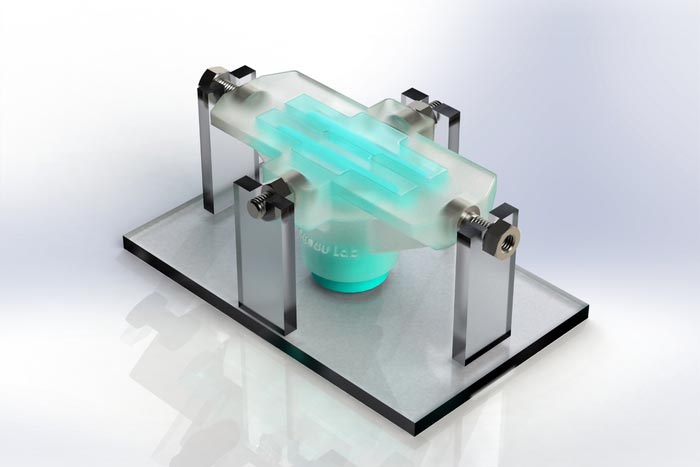Synthetic tissue can repair hearts, muscles, and vocal cords

A rendered image of the vocal cord bioreactor for testing the hydrogels.
Credit: Zixin He
Scientists from McGill University develop new biomaterial for wound repair.
Combining knowledge of chemistry, physics, biology, and engineering, scientists from McGill University develop a biomaterial tough enough to repair the heart, muscles, and vocal cords, representing a major advance in regenerative medicine.
“People recovering from heart damage often face a long and tricky journey. Healing is challenging because of the constant movement tissues must withstand as the heart beats. The same is true for vocal cords. Until now there was no injectable material strong enough for the job,” says Guangyu Bao, a PhD candidate in the Department of Mechanical Engineering at McGill University.
The team, led by Professor Luc Mongeau and Assistant Professor Jianyu Li, developed a new injectable hydrogel for wound repair. The hydrogel is a type of biomaterial that provides room for cells to live and grow. Once injected into the body, the biomaterial forms a stable, porous structure allowing live cells to grow or pass through to repair the injured organs.
“The results are promising, and we hope that one day the new hydrogel will be used as an implant to restore the voice of people with damaged vocal cords, for example laryngeal cancer survivors,” says Guangyu Bao.
Putting it to the test
The scientists tested the durability of their hydrogel in a machine they developed to simulate the extreme biomechanics of human vocal cords. Vibrating at 120 times a second for over 6 million cycles, the new biomaterial remained intact while other standard hydrogels fractured into pieces, unable to deal with the stress of the load.
“We were incredibly excited to see it worked perfectly in our test. Before our work, no injectable hydrogels possessed both high porosity and toughness at the same time. To solve this issue, we introduced a pore-forming polymer to our formula,” says Guangyu Bao.
The innovation also opens new avenues for other applications like drug delivery, tissue engineering, and the creation of model tissues for drug screening, the scientists say. The team is even looking to use the hydrogel technology to create lungs to test COVID-19 drugs.
“Our work highlights the synergy of materials science, mechanical engineering and bioengineering in creating novel biomaterials with unprecedented performance. We are looking forward to translating them into the clinic”, said Professor Jianyu Li, who holds the Canada Research Chair in Biomaterials and Musculoskeletal Health.
About this study
“Injectable, pore-forming, perfusable double-network hydrogels resilient to extreme biomechanical stimulations” by Sareh Taheri, Guangyu Bao, Zixin He, Sepideh Mohammadi, Hossein Ravanbakhsh, Larry Lessard, Jianyu Li, and Luc Mongeau was published in Advanced Science.
DOI: https://doi.org/10.1002/advs.202102627
Journal: Advanced Science
DOI: 10.1002/advs.202102627
Method of Research: Experimental study
Subject of Research: Lab-produced tissue samples
Article Title: Injectable, pore-forming, perfusable double-network hydrogels resilient to extreme biomechanical stimulations
Article Publication Date: 22-Nov-2021
Media Contact
Shirley Cardenas
McGill University
shirley.cardenas@mcgill.ca
Office: 514-398-6751
All latest news from the category: Life Sciences and Chemistry
Articles and reports from the Life Sciences and chemistry area deal with applied and basic research into modern biology, chemistry and human medicine.
Valuable information can be found on a range of life sciences fields including bacteriology, biochemistry, bionics, bioinformatics, biophysics, biotechnology, genetics, geobotany, human biology, marine biology, microbiology, molecular biology, cellular biology, zoology, bioinorganic chemistry, microchemistry and environmental chemistry.
Newest articles

Bringing bio-inspired robots to life
Nebraska researcher Eric Markvicka gets NSF CAREER Award to pursue manufacture of novel materials for soft robotics and stretchable electronics. Engineers are increasingly eager to develop robots that mimic the…

Bella moths use poison to attract mates
Scientists are closer to finding out how. Pyrrolizidine alkaloids are as bitter and toxic as they are hard to pronounce. They’re produced by several different types of plants and are…

AI tool creates ‘synthetic’ images of cells
…for enhanced microscopy analysis. Observing individual cells through microscopes can reveal a range of important cell biological phenomena that frequently play a role in human diseases, but the process of…





















